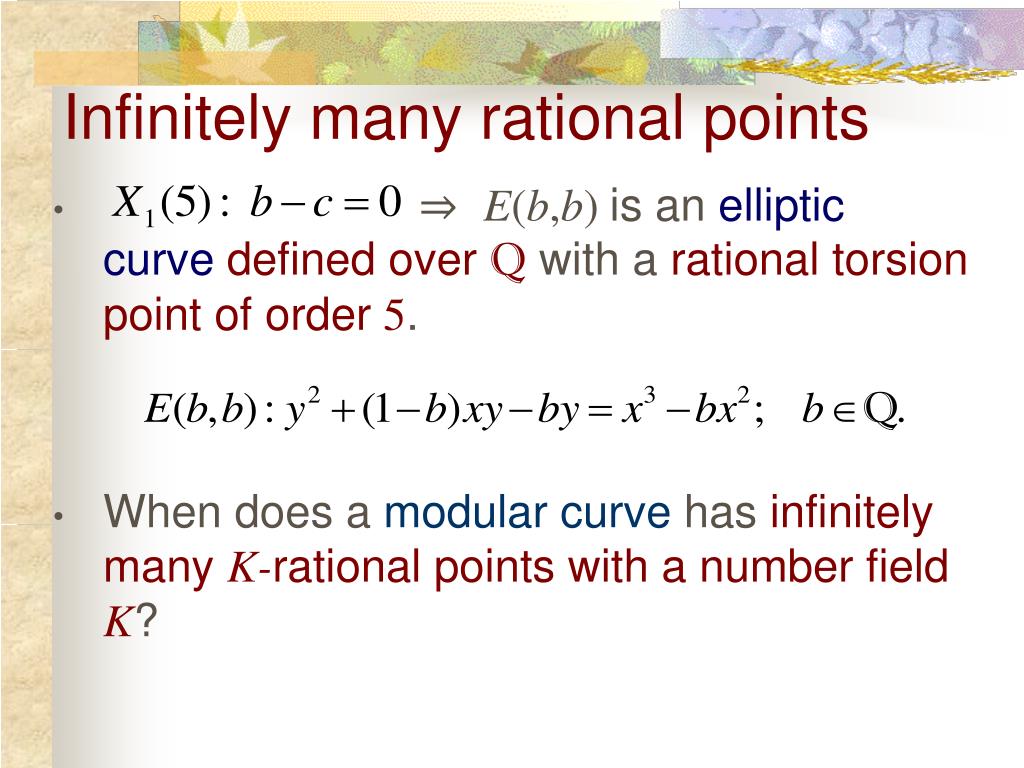Elliptic curves, an intriguing construct in the field of number theory and algebraic geometry, offer a rich landscape for exploration and inquiry, especially regarding their rational points. A rational point on an elliptic curve is defined as a point whose coordinates are rational numbers. The quest to understand how many such rational points can exist on an elliptic curve is both mathematically profound and practically significant.
An elliptic curve can be represented in a simplified Weierstrass form: y2 = x3 + ax + b, where a and b are rational coefficients. This geometrical representation creates a smooth and non-singular cubic curve, possessing remarkable properties. The structure of elliptic curves is much celebrated, particularly their symmetry and the group law governing the addition of points.
To begin with, one must acknowledge the definition of the set of rational points on an elliptic curve defined over the rational numbers, denoted as E(Q). The foundational work by Mordell and later developments by Weil posited that E(Q) is finitely generated. This assertion evokes a profound curiosity; while such curves might exhibit a myriad of real and complex coordinates, what constrains the rational counterparts?
One of the most celebrated results in this domain is the Mordell-Weil Theorem. This theorem states that the group of rational points on an elliptic curve over the rational numbers is finitely generated, meaning that it can be expressed as a direct sum of a finite torsion subgroup and a free abelian group of finite rank. Essentially, this implies that the rational points can be thought of as forming a structured group, facilitating the analysis of their existence and quantity.
Moreover, the rank of the group of rational points becomes a pivotal concept. The rank, intuitively speaking, can be thought of as the number of independent generators of the group of rational points. Higher ranks suggest a richer field of rational points, while a rank of zero hints at a more sparse landscape. For instance, the well-known example of the famous elliptic curve y2 = x3 + x possesses an infinite number of rational points, while others, like y2 = x3 + 1, have only a few.
Interestingly, the distribution of these rational points is not random; it is informed by myriad factors, including the discriminant and the arithmetic properties of the coefficients a and b. The discriminant serves as a gatekeeper, delineating the curve’s flexibility in accommodating rational solutions. A curve with a non-square discriminant might inherently limit the possibilities for rational solutions, leading to a tantalizing interplay between number theory and geometry.
Furthermore, the relationship between elliptic curves and modular forms opens up even deeper avenues of inquiry. The Taniyama-Shimura-Weil Conjecture, recently proven as a theorem, posits that every elliptic curve is associated with a modular form. This profound linkage elucidates the nature of rational points through an entirely different lens, underscoring the unity within disparate realms of mathematics.
On a more technical front, the notion of the Selmer group provides insight into the rational points’ cardinality. By analyzing the Selmer group, which describes an obstruction to the existence of rational points relative to a chosen prime, one can derive both the rank of the elliptic curve and the nature of the rational points. The intricate balance between the curve’s geometry and its algebraic properties continuously yields fruitful insights and challenges.
Moreover, computational techniques significantly aid in investigating rational points. Through the algorithmic approach, one can employ tools such as the Chabauty–Coleman method, which allows for an explicit computation of the set of rational points under specified conditions. As computational power continues to evolve, one anticipates more straightforward methods to accurately predict or determine the quantity of rational points on arbitrary elliptic curves.
There are, however, exceptions. Not all elliptic curves abide by the same rules governing the abundance of rational points. It remains critical to remain cognizant of the exceptional cases, including those possessing no non-trivial rational points or those whose solutions are intricately tied to unresolved conjectures in mathematics.
In conclusion, the inquiry surrounding how many rational points can exist on an elliptic curve is a kaleidoscopic journey through a rich mathematical landscape. Each curve tells its own story, revealing patterns influenced by various factors, from ranks and discriminants to their association with modular forms. The compact yet profound nature of the results associated with elliptic curves piques the curiosity of mathematicians and enthusiasts alike, establishing a timeless connection between the abstract and the tangible, the theoretical and the computational.
The enduring fascination with rational points on elliptic curves lies not just in their enumeration, but in the profound insights they provide into the broader structure of mathematics, bridging number theory with the enigmatic properties of curves. As the field continues to evolve, the exploration of rational points will undoubtedly remain a central theme, inspiring both questions and answers in future mathematical discourse.








Leave a Comment